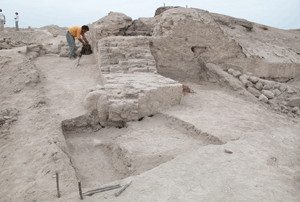
The ruins of a sixteenth century Peruvian town reveal a resilient native culture

At the site of Magdalena de Cao Viejo, written as "mag de Cao" in the third line of a paper fragment found there, excavations are revealing how the cultures of the Spanish conquerors and indigenous people mixed.
(Courtesy Jeff Quilter)
The Spanish conquest of Peru remains one of the most dramatic examples, in history, of civilizations colliding. In just a few years in the early sixteenth century, a few hundred Spanish soldiers and their local allies toppled an empire of 16 million people covering an area one-fifth the size of Europe. The result was a fusion of European and indigenous cultures that, with some later input from Africa and Asia, makes up Peruvian society today.
Most of our understanding of this period has been limited to just a few written sources. Almost all of them are from Spanish politicians and historians—the voices of the victors—describing complex events in broad, often biased strokes.
Jeffrey Quilter of Harvard University is leading a project at a tiny sixteenth-century settlement on the northern coast of Peru that he hopes will change that. Since 2004, his team has been excavating Magdalena de Cao Viejo in the lower Chicama River Valley, 50 miles from Trujillo. The windswept site is yielding a trove of artifacts from these early turbulent decades that are astonishingly well-preserved, even by the standards of the dry Peruvian coast, including a collection of handwritten and printed papers unequaled in the New World.
Race and ethnicity are still hot-button issues in modern Peru, but nothing like they were in the chaotic century after the Spanish arrived in 1532. The 1570s and 1580s in particular were the real transition point from the era of the Inca to the colonial period, Quilter says. Pockets of native resistance still held out, but the execution of the last Inca leader, Túpac Amaru, and the destruction of the indigenous state of Vilcabamba in 1572 had ended any serious hope of driving the newcomers out.

To read more, find ARCHAEOLOGY in your local newsstand or bookstore, or click here to buy a copy of the issue online. And if you'd like to receive ARCHAEOLOGY in your mailbox, click here to subscribe.
Julian Smith is a travel and science writer and photographer based in Santa Fe.
Advertisement

Advertisement







